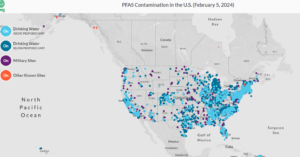“A huge victory for public health”: EPA set limits on PFAS toxins in drinking water
US regulators on Wednesday put in place the nation’s first legally enforceable limits for levels of six toxic PFAS chemicals in drinking water, saying the moves should prevent thousands of deaths and reduce serious illnesses in people across the country.
The rule is designed to reduce exposure to these per-and polyfluoroalkyl substances (PFAS) – also called “forever chemicals” – for about 100 million people nationwide, according to the US Environmental Protection Agency (EPA). Exposure to PFAS has been linked to “deadly cancers, impacts to the liver and heart, and immune and developmental damage to infants and children,” the EPA said.
“Today we can celebrate a huge victory for public health in this country,” Rob Bilott, a lawyer who has become famous for his work against PFAS, said in a statement. Bilott has spent decades pushing for PFAS regulations and for holding PFAS manufacturers accountable for releasing the dangerous chemicals into the marketplace.
“It should never have taken this long to address such serious threats to public health and our environment,” Bilott said, noting that he first alerted the EPA to the presence of PFAS in US drinking water more than twenty-three years ago.
The new rule sets a limit of four parts per trillion (ppt) for two types of PFAS – perfluorooctanoic acid (PFOA) and perfluorooctanesulfonic acid (PFOS), which are both known to be particularly hazardous.
The EPA acknowledged that there is “no level of exposure to these contaminants without risk of health impacts, including certain cancers,” and said it was setting a “non-enforceable health-based goal,” at zero for PFOA and PFOS.
The rule also established limits of 10 ppt for perfluorohexanesulphonic acid (PFHxS), perfluorononanoic acid (PFNA), and hexafluoropropylene oxide (HFPO) dimer acid and its ammonium salt, known as GenX chemicals. Additionally, it sets a limit for mixtures containing two or more of these chemicals as well as perfluorobutane sulfonate (PFBS).
Water bill warning
Public drinking water systems will have three years to complete initial monitoring for the six PFAS chemicals and will be required to inform the public of PFAS levels they detect. Systems that detect PFAS levels exceeding the new standards will then have an additional two years to implement solutions, such as installing granulated activated carbon filters.
 The EPA estimates that about 6-10% of 66,000 public drinking water systems may need to take action to reduce PFAS levels in order to meet the standards. The agency said $1 billion in newly available funding should help both public water systems and private well owners test for and treat PFAS contamination. The funding is part of $9 billion allocated through the Bipartisan Infrastructure Law to help communities with contaminated drinking water, the EPA said.
The EPA estimates that about 6-10% of 66,000 public drinking water systems may need to take action to reduce PFAS levels in order to meet the standards. The agency said $1 billion in newly available funding should help both public water systems and private well owners test for and treat PFAS contamination. The funding is part of $9 billion allocated through the Bipartisan Infrastructure Law to help communities with contaminated drinking water, the EPA said.
Industry groups representing water utilities have said the government funding assistance will not be enough to enable utilities to comply with the new standards. The American Water Works Association estimates that the cost of implementing the rule will be three times higher than what the agency has calculated.
“The final regulation for several PFAS will prove exceedingly costly for the communities and ratepayers across the country that are already struggling to replace lead service lines, address water scarcity, and upgrade aging infrastructure,” the Association of Metropolitan Water Agencies said in a statement. “There simply are not enough federal funds to offset the large increases in water bills that will be required to support utilities’ operational and capital investments and EPA’s growing list of mandates.”
A “baby step”
Some health and environmental advocates said the EPA is not going far enough to protect the public from PFAS.
Tim Whitehouse, executive director of the watchdog group Public Employees for Environmental Responsibility (PEER) and a former senior EPA enforcement attorney, congratulated the Biden administration in a statement for “sticking to its guns” despite industry opposition.
“Yet today’s action represents only a baby step because effective control of PFAS will require a cradle-to-grave regulatory regime from manufacture to ultimate disposal,” Whitehouse said.
The agency is ignoring evidence that different types of PFAS can degrade into PFOA and PFOS when they are incinerated, chlorinated or otherwise broken down, according to PEER. The organization said it is also concerned that the EPA “allows industry to substitute new PFAS variations faster than EPA can regulate them.”
The new finalized standard is part of an ongoing debate about how the government should address the nation’s widespread PFAS contamination problem.
A US Senate Committee on Environment and Public Works hearing last month discussed the EPA’s proposal to designate PFOS and PFOA as hazardous substances under the Comprehensive Environmental Response, Compensation, and Liability Act (CERCLA).
Representatives of water and wastewater treatment systems fear that hundreds of such operations could face litigation for chemicals they never used or produced if they are not issued an exemption from liability. Environmental advocates argued that giving some sectors an exemption could ultimately help polluters evade liability.
Widespread and pervasive
PFAS chemicals don’t break down naturally and can leach into drinking water from sources including industrial releases, landfills, and sewage treatment plants. An estimated 70 million people in the US have PFAS in their drinking water, according to new EPA data from one third of public water systems released in February, while the Environmental Working Group (EWG) estimates that the number may be as high as 200 million.
PFAS chemicals have been linked to numerous health effects, including thyroid, kidney, and immune system problems. An international cancer group recently classified PFOA as carcinogenic to humans and PFOS as possibly carcinogenic to humans.
The EPA first became aware that PFAS chemicals cause health effects in 1998. In 2016, the agency set a non-enforceable health advisory level of 70 ppt for PFOS and PFOA in drinking water. In 2022, the EPA issued interim updated advisory levels of 0.02 ppt for PFOS and 0.004 ppt for PFOA. Many states set their own drinking water standards for the chemicals prior to the EPA’s finalized MCLs.
Last summer, 3M, Dupont, and related chemical companies reached settlements requiring them to pay a total of over $13 billion to water systems across the country for allegedly contaminating US drinking water with the harmful chemicals despite knowing for decades that PFAS threaten human health and the environment.
In the wake of the landmark settlements, personal injury lawsuits have started to move forward for people who developed diseases after drinking water that was contaminated by firefighting foam laced with PFAS.
New rules to limit the release of PFAS into the air and water are expected soon, according to Scott Faber, senior vice president of government affairs at EWG.
 EWG
EWG


